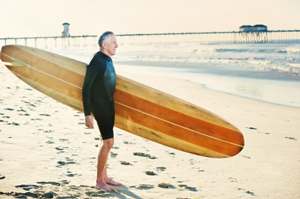How to Surf for Life
 Surfing is clearly one of those sports that you can take up at any age and continue to pursue throughout your life. Numerous men and women all over the globe surf into their 70s, 80s, and even 90s. On the flip side, countless surfers are forced to call it quits much earlier than they want. This can happen for a variety of reasons.
Surfing is clearly one of those sports that you can take up at any age and continue to pursue throughout your life. Numerous men and women all over the globe surf into their 70s, 80s, and even 90s. On the flip side, countless surfers are forced to call it quits much earlier than they want. This can happen for a variety of reasons.
Choosing to no longer feel the “stoke” of riding waves is one thing, but it can be disheartening when you’re unable to enjoy an activity that brings tremendous happiness to your life. If imagining an existence void of surfing makes you nauseous, have a seat, take a deep breath and read on.
Better with Age
Once you’re hooked, surfing can become both an addiction and an essential part of your lifestyle. And, because riding waves requires skill, surfing can challenge you for a lifetime; and you can continue to improve for decades. Prime examples are world-class rippers like Kelly Slater (World Champ in 2010 at age 38), Layne Beachley (World Champ in 2006 at age 34), and Laird Hamilton (still leading the big-wave charge at age 46). These men have been dominating and raising the level of their surfing for several years.
However, it doesn’t stop there. Spend a little time in Hawaii and California, or at virtually any decent break in the world, and you’re bound to witness some amazingly high-level surfing by wave slayers over the age of 50.
Why Surf for Life?
Here are a few advantages of being a lifelong surfer:
- Paddling and maneuvering a surfboard helps you remain active, fit, and healthy.
- Being in the ocean and challenging yourself is a great way to alleviate stress.
- Playing in the waves keeps you younger, smiling, and having fun!
John H. "Doc" Ball (1907-2001) was the epitome of inspiration. He was not only surfing cold-water breaks in Northern California in his 90s, but he was doing it without a wetsuit! Doc started riding waves in 1929 and authored “California Surfriders” in 1946. He was a dentist, a co-founder of California’s first surf club, one of the worlds best-known surf photographers, and stayed stoked about life until the very end.
Keys to Lifelong Surfing
Here are some ways to ensure that you’ll be able to surf as long as you want:
Live Well
Limiting intake of processed foods, getting adequate rest so the body can repair itself, controlling your weight to maintain a high energy level, and managing stress, are all vital elements of an active lifestyle. And, if you’re serious about staying spry later in life, avoid polluting yourself with too many toxins. Take care of yourself and stick to healthy addictions.
Stay Fit
Exercising out of the water is also extremely important in order to maintain strength, flexibility, and trunk stability. Tight muscles will make paddling, popping up, and getting low a challenge; and as we age, we need to spend more time stretching to prevent stiffness — cross-training activities such as yoga can be very beneficial. Lower-back pain is a common issue that sidelines seasoned surfers. So, watch your posture and keep your core strong — especially lower abdominal muscles.
Know your Limits
This is necessary for surfers at every age and experience level. It’s healthy to push the envelope and expand your comfort zone, but do it gradually. A lot of career-ending surf injuries result from putting the body in situations that far exceed its abilities. Accidents happen; that’s part of being active. Just know that many accidents can be avoided.
Adapt
Adjust your expectations as you get older. Some folks give up surfing once they’re unable to surf as often, surf at the same level, or surf in the same way that they did when they were “younger.” Sure, certain time constraints and/or business obligations may force you to surf less at points of your life. The important thing is that you still get out there from time to time, even if it’s just once a month or a handful of times per year. It’s also important to be selective about the conditions in which you surf, where you surf, and what board you surf as you grow older. If paddling a shortboard becomes too strenuous, switch to a longboard. If popping up is an issue, try stand-up paddle surfing. The important thing is that you’re out there riding waves.
Stay Stoked
 Having a great attitude is key. Enjoy the surfing lifestyle and share the “stoke” with friends whenever possible. Take more breaks, shorten your sessions, and pace yourself in order to keep the quality of your surfing as high as possible. Occasional extended breaks between sessions can also keep things fresh and remind you of the main reason you continue to surf — because you love it!
Having a great attitude is key. Enjoy the surfing lifestyle and share the “stoke” with friends whenever possible. Take more breaks, shorten your sessions, and pace yourself in order to keep the quality of your surfing as high as possible. Occasional extended breaks between sessions can also keep things fresh and remind you of the main reason you continue to surf — because you love it!
Your Choice
Although attrition is a great form of crowd control at your local break, the world would be a better place if everyone surfed periodically. So, if surfing makes your life even a little sweeter and puts you in a better mood, you owe it to yourself and those who put up with a non-wave-riding version of you, to continue surfing for life!
